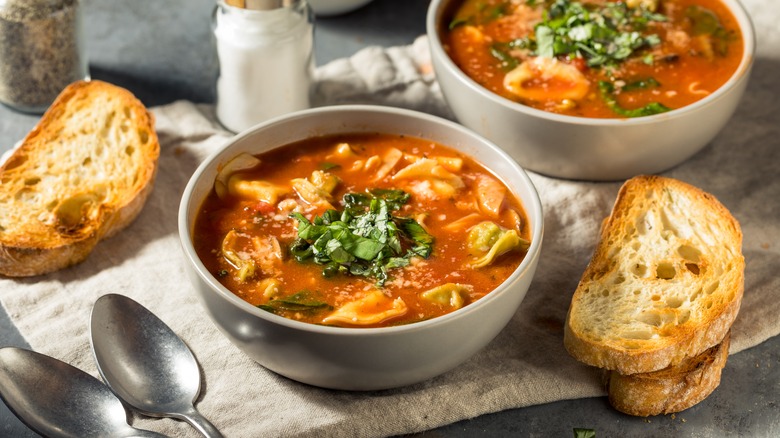A Touch Of Balsamic Vinegar Brings Out A Bright Acidity In Tortellini Soup
Whether chasing off winter chills or simply craving the warmth of a hearty meal, there's nothing quite like a creamy tomato tortellini soup. It embodies the essence of home cooking in a nourishing bowl of goodness while combining the flavors you love: saucy tomatoes, fresh veggies, aromatic herbs, and cheesy tortellini. But there's one little secret splash that kicks things way up while also brightening the overall tone of the dish.
That sassy something likely inhabits your pantry or refrigerator door already, and it originated in Italy, just like the tortellini soup bubbling on your stovetop. It's the lusciously dark, intensely flavored balsamic vinegar. Because balsamic is so robust, it only takes a couple of dashes to have a transformative effect on soup. If you're the measuring type of chef, start with two teaspoons, let it rest in the soup for a couple of minutes, then either leave it be or keep on splashing and dashing.
Just be careful not to overpower all those other tasty components of a creamy homemade tortellini soup. It also helps to remember that, although balsamic vinegar can be seductively sweet depending on aging and fermentation methods, it's still acidic. This makes the tomatoes in the soup pop with flavor, but you don't want so much acid that it detracts from the rich and smooth status of your soup.
Infusing tortellini soup with balsamic vinegar
There are a couple of considerations when infusing tortellini soup with the rich complexity of balsamic vinegar. First is the point at which you add the vinegar. Some recipes call for mixing it right in with other soup ingredients such as broth, garlic, tomatoes, and spices. That way, it permeates the soup and is part of the overall flavor tones. However, it gives you less control of the vinegar's effect. Adding it at the end, after the soup is fully cooked, allows splashing and stirting, and then adjusting accordingly. This approach also lets you add balsamic to any existing creamy tomato tortellini soup recipe.
The type of balsamic you choose can make a difference as well, as some are much more intense than others. All balsamic vinegars are made from what's known as grape must, which is pure sweet juice from fresh-pressed grapes. It's then concentrated and fermented in wood barrels, with the aging times creating noticeably different flavors. Traditional hand-crafted balsamic vinegars can age for at least a dozen years, resulting in a thick, intense balsamic that's sweeter than commercially produced varieties.
The kind available in a typical supermarket usually comes from grape must mixed with wine vinegars and aged for a few months or up to three years. Unless you're a devoted vinegar traditionalist, this is the option you'll likely use. It has a thinner consistency, making it easier to cook with and measurably lighter and tangier in your soup.

